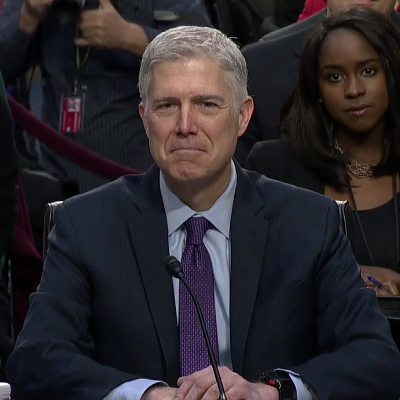GOP could try these 'nuclear option' alternatives to put Gorsuch on the Supreme Court

Judge Neil Gorsuch. U.S. Capitol photo.
Senate Republicans who want to put Judge Neil Gorsuch on the U.S. Supreme court don’t necessarily have to resort to the “nuclear option,” which means reducing the number of votes needed to end a filibuster from 60 to 51.
Some Republicans are reluctant to change the rules because the tables could be turned in the future when they want to stop a Supreme Court nomination, BuzzFeed News reports. The article explores two alternatives, including a procedure known as the “two-speech rule.”
The first vote on Gorsuch is scheduled on April 3, when the Senate Judiciary Committee votes on whether to forward the nomination to the Senate. Republicans control the committee 11-9, and committee approval is expected, according to the article.
Next, Senate Majority Leader Mitch McConnell likely will file a cloture petition to allow only 30 hours of debate on the Gorsuch nomination. Two days after the cloture petition is filed, there is a vote on whether to invoke cloture and, under current rules, 60 votes are needed. There are 52 Republicans in the Senate, and at least eight Democrats would be needed. (The nuclear option has already been invoked for lower court and executive branch nominees.)
Republicans could invoke the nuclear option to require only a majority vote to end the debate. Or they could resort to the two-speech rule that has been pushed by the Heritage Foundation.
The rule limits senators to just two speeches in a legislative day. If the Senate doesn’t adjourn for the night, a legislative day could last days, weeks or even months, BuzzFeed News explained. Democratic moves to end the legislative day could be nixed with a majority vote of the senators present. After Democratic senators each give two speeches, a vote would be taken, and only a simple majority would be needed for confirmation.
One problem with the idea—there is no limit on speech length, provided that the senator keeps speaking and doesn’t sit down. “Think: Mr. Smith Goes to Washington dozens of times over—times two,” BuzzFeed News said.
A second option is a recess appointment. The Senate could go into recess as planned on April 7. Before it returns on April 24, President Donald Trump could put Gorsuch on the Supreme Court through a recess appointment that lasts through the next session of Congress—which would end in late 2018 or 2019.
Democrats could try to delay the recess, however. One possibility would be to require a reading of the journal, which is a reading of the minutes of the past Senate day, including the full text of any bills that had been introduced. Legal challenges to the recess appointment also would be a possibility.



